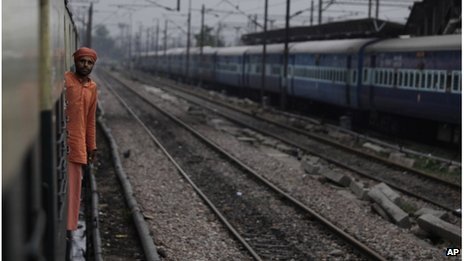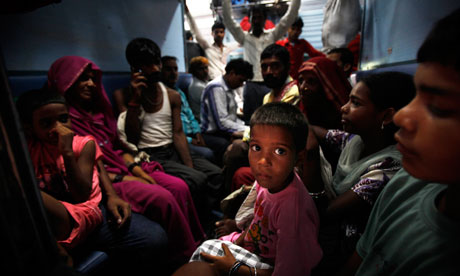Informer
JF-Expert Member
- Jul 29, 2006
- 1,582
- 6,627
July 30, 2012 | BBC

Trains were stranded after the outage
A massive power cut has caused disruption across northern India, including in the capital, Delhi.
It hit a vast swathe of the country affecting more than 300 million people in Punjab, Haryana, Uttar Pradesh, Himachal Pradesh and Rajasthan states.
Power Minister Sushil Kumar Shinde said 60% of the supply had been restored and the rest would be reinstated soon.
It is unclear why supply collapsed, but states using more power than they were authorised to could be one reason.
Mr Shinde said he had appointed a committee to inquire into the causes of the blackout, one of the worst to hit the country in more than a decade.
Travel chaos
The outage happened at 02:30 local time (2100 GMT) on Monday after India's Northern Grid network collapsed.
Monday morning saw travel chaos engulf the region with thousands of passengers stranded when train services were disrupted in Punjab, Haryana and Chandigarh.
Delhi Metro railway services were stalled for three hours, although the network later resumed service when it received back-up power from Bhutan, one official said.
Traffic lights on the streets of the capital were not functioning as early morning commuters made their way into work, leading to gridlock.
Water treatment plants in the city also had to be shut for a few hours.
Officials said restoring services to hospitals and transport systems were a priority.
Power cuts are a common occurrence in Indian cities because of a fundamental shortage of power and an ageing grid. The chaos caused by such cuts has led to protests and unrest on the streets.
Earlier in July, crowds in the Delhi suburb of Gurgaon blocked traffic and clashed with police after blackouts there.
Correspondents say that India urgently needs a huge increase in power production, as hundreds of millions of its people are not even connected to the national grid.
Prime Minister Manmohan Singh has long said that India must look to nuclear energy to supply power to the people.
Estimates say that nuclear energy contributes only 3% to the country's current power supply. But the construction of some proposed nuclear power stations have been stalled by intense local opposition.

Trains were stranded after the outage
A massive power cut has caused disruption across northern India, including in the capital, Delhi.
It hit a vast swathe of the country affecting more than 300 million people in Punjab, Haryana, Uttar Pradesh, Himachal Pradesh and Rajasthan states.
Power Minister Sushil Kumar Shinde said 60% of the supply had been restored and the rest would be reinstated soon.
It is unclear why supply collapsed, but states using more power than they were authorised to could be one reason.
Mr Shinde said he had appointed a committee to inquire into the causes of the blackout, one of the worst to hit the country in more than a decade.
Travel chaos
The outage happened at 02:30 local time (2100 GMT) on Monday after India's Northern Grid network collapsed.
Monday morning saw travel chaos engulf the region with thousands of passengers stranded when train services were disrupted in Punjab, Haryana and Chandigarh.
Delhi Metro railway services were stalled for three hours, although the network later resumed service when it received back-up power from Bhutan, one official said.
Traffic lights on the streets of the capital were not functioning as early morning commuters made their way into work, leading to gridlock.
Water treatment plants in the city also had to be shut for a few hours.
Officials said restoring services to hospitals and transport systems were a priority.
Power cuts are a common occurrence in Indian cities because of a fundamental shortage of power and an ageing grid. The chaos caused by such cuts has led to protests and unrest on the streets.
Earlier in July, crowds in the Delhi suburb of Gurgaon blocked traffic and clashed with police after blackouts there.
Correspondents say that India urgently needs a huge increase in power production, as hundreds of millions of its people are not even connected to the national grid.
Prime Minister Manmohan Singh has long said that India must look to nuclear energy to supply power to the people.
Estimates say that nuclear energy contributes only 3% to the country's current power supply. But the construction of some proposed nuclear power stations have been stalled by intense local opposition.
